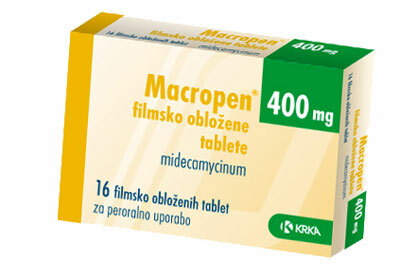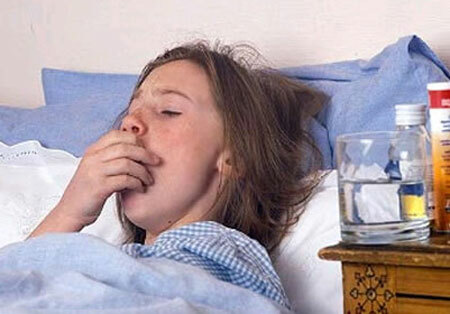Contrary to the fact that the disease is considered a purely childhood infectious disease, pertussis in adults is not so rare and occurs periodically in clinical practice. Its manifestation is acute, cyclical, with characteristic specific symptoms.
The disease is caused by the Bordet-Gunga rod of the genus( Bordetell) Bordetell. Getting on the mucous membrane of the human respiratory system, causes the development of inflammatory processes that provoke increased secretion of mucus, while suppressing the activity and functions of the ciliated epithelium of the mucous tissue, contributing to the formation of foci of necrosis.
Pathology actively develops in bronchial tissues, affecting the upper respiratory tract. The body develops hypersensitivity( sensitization) to the toxins of the pathogen, caused by stimulation of the mucosal layer receptors of the respiratory system, manifested by paroxysmal convulsive cough - such symptoms of whooping cough in adults and children are the "calling card" of the disease.
Infection occurs by direct contact of a person with a patient or carrier of infection, that is, by contact and aerosol. A simple sneeze or cough at a distance of 1-2 meters can transfer the infection from the patient to the healthy one. The peak of virulence( infectiousness) of the bacterium falls on the first seven days of illness and the last days of the latent period.
It is during this time period that the diseased should be isolated. The most dangerous are patients with indistinct mild symptoms.
The first signs of whooping cough may appear in a week or one and a half, after the moment of infection. The course of the disease is due to three stages of development - catarrhal( initial), paroxysmal( spasmodic) and stage of resolution( reverse development).
Contents
- 1 Symptoms and signs of whooping cough in adults
- 1.1 What is the risk of adult disease?
- 2 Diagnosis of whooping cough
- 3 Treatment and prevention of pertussis
Symptoms and signs of pertussis in adults

With the first symptoms of whooping cough in adults, the initial phase of the disease begins - catarrhal stage.
The main symptom of the disease at this stage is a constant dry cough, which is not stopped by any medications. Symptoms very much resemble the clinic ORZ:
- febrile state with a very high temperature;
- general weakness and loss of appetite;
- runny nose, cough and lacrimation.
It is because of this, treatment of whooping cough is adults who often start on their own, focusing on compliance with catarrhal pathologies - as a rule, it does not bring relief.
The period of the paroxysmal ( spasmodic) stage is the most severe, accompanied by impairment of respiratory functions. Cough intensifies, takes a suffocating character. At the same time, thick viscous mucus and whistling sounds are released. Attacks can occur up to 50 times a day. The patient blushes face, cervical lymphadenitis develops. In his zone, the cyanosis of the skin is marked.
Often, coughing episodes can cause unpleasant moments with spontaneous urination and defecation. If during this period, do not undergo the appropriate examination and treatment of pertussis, the symptoms can be supplemented:
- convulsions throughout the body;
- with neurogenic syncope;
- meningeal symptoms;
- disorders of cerebral circulation.
The stage of resolution of ( reverse development) is the final stage of the disease. The state of health improves, breathing returns to normal, coughing attacks worsen less and less. The patient is on the mend.
With adequate timely treatment, the total duration of whooping cough in an adult does not exceed one and a half, two months.
How dangerous is the disease for adults?

the first signs of whooping cough in adults( photo), they are similar to the common cold
The greatest danger in whooping cough in adults is the development of complications with possible pathological processes in the form of:
- acute inflammatory processes in the lungs;
- involvement in the inflammatory process of bronchial tissues;
- development of exudative pleurisy and emphysema;
- purulent inflammatory processes in the structure of the middle ear.
Sometimes, the consequences of whooping cough are manifested by lung atelectasis, frequent attacks of coughing can provoke:
- hypophagmus - hemorrhage in conjunctiva;
- hernial umbilical and inguinal protrusions;
- perforation( opening or rupture) in the eardrums;
- rectal prolapse( prolapse of the intestine).
When another diagnosis is added to the main pathology, this means - a complication of the disease, in this case pertussis. Infections are susceptible even to previously vaccinated people.
In this case, the disease can proceed at an accelerated pace, without a cough reflex, without any external signs and characteristic symptoms. To diagnose the disease in this case, it is possible only for the detection of antibodies of class "M" in the blood -( IgM).
Diagnosis of whooping cough
Thanks to a variety of modern diagnostic techniques, today clinicians have every opportunity to detect this infection at any stage of its course. Analgesia for whooping cough is carried out by methods:
- Bacteriological study( seeding) of mucus taken from the mucous membrane of the oropharynx.
- Reaction tests of RNGA, RPGA and RA are serological methods used in the detection of the pathogen in the late stages of the disease.
- Analysis ELISA is an enzyme-linked immunosorbent assay that detects the antibodies of the bacterium at the early( IgM) stage of the disease and at the late -( IgG)
- . The diagnostic procedure is a RNIF technique that allows to detect the antibody and confirm pathology within two hours. Simultaneously having carried out the differentiated diagnosis with similar pathologies. And the LMA method, which determines the disease within half an hour.
- Molecular and hematological studies.
Treatment and prevention of pertussis
 In the treatment of pertussis in adults, a standard therapeutic regimen is used, including:
In the treatment of pertussis in adults, a standard therapeutic regimen is used, including:
- Etiotropic therapy - in the first week of the disease, penicillin group preparations are prescribed, such as Amoxiclav or Flemoclav. In the next four days, drugs of macrolide antibiotics - Erythromycin, Macropen or Azithromycin, Rulid, Klabaks or their analogs are connected. Treatment of whooping cough with antibiotics after 10 days is inexpedient. Their appointment is justified only with purulent complications.
- With pronounced processes of respiratory failure, pulmonary edema, cerebral circulation insufficiency, a drip intravenous solution of euphyllin is prescribed.
- Anxiolytics in the form of Seduxen, Relanium or Sibazon are prescribed for severe coughing attacks.
- Gluculocorticoid preparations( Prednisolone) and diuretics( Lasix) are prescribed for pulmonary edema.
- Oxygen therapy is very effective for treating oxygen( artificial ventilation, or in special wards).
In the absence of temperature, at any time of the year, patients are recommended to walk in the air for at least an hour. Food should be frequent, divided and vitaminized.
Prevention measures
The main measure of prevention is the timeliness of vaccination. The vaccine protects a person from whooping cough for fifteen years. Then it must be done again. Immunity to the causative agent persists in the body throughout life.
Even with infection of the vaccinated patient, the disease will proceed in a milder form. To prevent re-infection, only a strong immune defense can. For this, it must be strengthened in every possible way.



